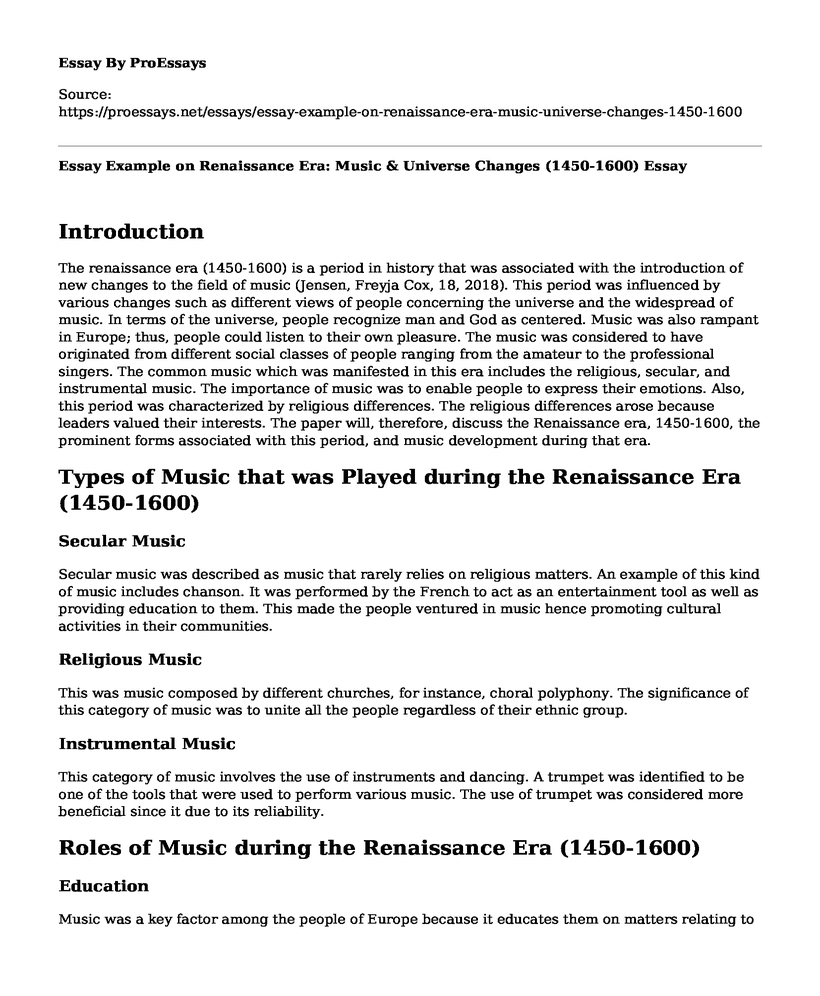Introduction
The renaissance era (1450-1600) is a period in history that was associated with the introduction of new changes to the field of music (Jensen, Freyja Cox, 18, 2018). This period was influenced by various changes such as different views of people concerning the universe and the widespread of music. In terms of the universe, people recognize man and God as centered. Music was also rampant in Europe; thus, people could listen to their own pleasure. The music was considered to have originated from different social classes of people ranging from the amateur to the professional singers. The common music which was manifested in this era includes the religious, secular, and instrumental music. The importance of music was to enable people to express their emotions. Also, this period was characterized by religious differences. The religious differences arose because leaders valued their interests. The paper will, therefore, discuss the Renaissance era, 1450-1600, the prominent forms associated with this period, and music development during that era.
Types of Music that was Played during the Renaissance Era (1450-1600)
Secular Music
Secular music was described as music that rarely relies on religious matters. An example of this kind of music includes chanson. It was performed by the French to act as an entertainment tool as well as providing education to them. This made the people ventured in music hence promoting cultural activities in their communities.
Religious Music
This was music composed by different churches, for instance, choral polyphony. The significance of this category of music was to unite all the people regardless of their ethnic group.
Instrumental Music
This category of music involves the use of instruments and dancing. A trumpet was identified to be one of the tools that were used to perform various music. The use of trumpet was considered more beneficial since it due to its reliability.
Roles of Music during the Renaissance Era (1450-1600)
Education
Music was a key factor among the people of Europe because it educates them on matters relating to their behaviors such that every person who had undergone education was encouraged to venture into music.
Expression of Emotions
The majority of the music during this period was sung with the purpose of expressing one's feelings; therefore, living a happier life.
Characteristics of Renaissance Music
Words and Music
Music was mostly written to show different meanings and more so the emotions of people. whereas words were used to represent images.
Rhythm and melody
Music flow from one rhythm to another hence breaking monotony of narration. Melody was also included in order to create a favorite tone.
Prominent Forms of Music
1.French Chansons
This song had varied voices ranging from two to four voices. Also, this form was characterized by short songs, and it could be performed by anybody.
2.Mass
This form was classified on the basis of modes.
3.Motet
It was associated with the use of initial words of music.
4.Chorale
This form was unique since it consists of sacred music, and it was mostly used by traditional protestant.
5.Madrigals
This was music that was sung by more than four people, and they majorly emphasized love. The purpose of these songs was to entertain specific people, such as an amateur.
Major Developments
Rise in humanism
Humanism was one of the developments which existed in the renaissance period. Some people rose to help others with knowledge about music. Firstly, they established schools for them. This institution of learning was more significant to them because it provided the basis of the study, thus enabling people to gain more knowledge on how to compose various songs. Also, it enables them to write more songs since they had knowledge of music presentation (Wright, Craig, 20, 2013).
Use of literacy
The composing of songs also changed. People were taught how to read and write songs.
The emergence of new music instruments
New instruments for music were introduced in order to ease work unlike before, where people could use trumpets as a way of conveying messages contained in their songs.
Introduction of new genres
Also, genres were introduced so as to ensure the proper flow of songs from one line to another. Moreover, genres also enhance rhythm hence breaking the monotony of narration.
Societal Structures Informed Music during the Renaissance (1450-1600)
The renaissance period brought a lot of influence on the people of Europe. This period affected people socially. Most of the music was played in various churches, specifically by religious leaders (Hart, Jonatha, 22, 2014). The music which was played in the church was valued because it united them hence eliminating ethnicity in terms of music performance. Music also aided in the advocation of social justice. Most of the songs which were being sung by the different artist had messages pertaining to the provision of equality in the music industry. Through the adoption of fairness, people were able to pass their messages hence creating a humane society where all people could express their feelings concerning what is affecting them.
Works Cited
Hart, Jonathan. Reading the Renaissance (Routledge Revivals): Culture, Poetics, and Drama. Routledge, 2014.
Jensen, Freyja Cox. "The popularity of ancient historians, 1450-1600." The Historical Journal 61.3 (2018): 561-595.
Wright, Craig. Listening to music. Nelson Education, 2013.
Cite this page
Essay Example on Renaissance Era: Music & Universe Changes (1450-1600). (2023, Apr 05). Retrieved from https://proessays.net/essays/essay-example-on-renaissance-era-music-universe-changes-1450-1600
If you are the original author of this essay and no longer wish to have it published on the ProEssays website, please click below to request its removal:
- Missouri's Role in the Civil War
- Film Analysis Essay on The New Asylums: Treatment Of Mentally Ill Offenders
- Essay Sample on Graphic Designers and Digital Media
- Sport & TV: Perfect Business Partners? - Essay Sample
- Essay Example on The Twelve Greek Pantheons: Immortals of Greek Mythology & Religion
- Essay Example on Mexican-Americans During WWII: A Perspective
- Paper Sample on Music: Enhancing Lives and Connecting People







